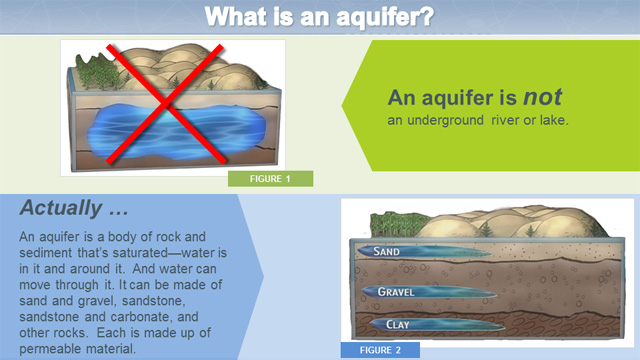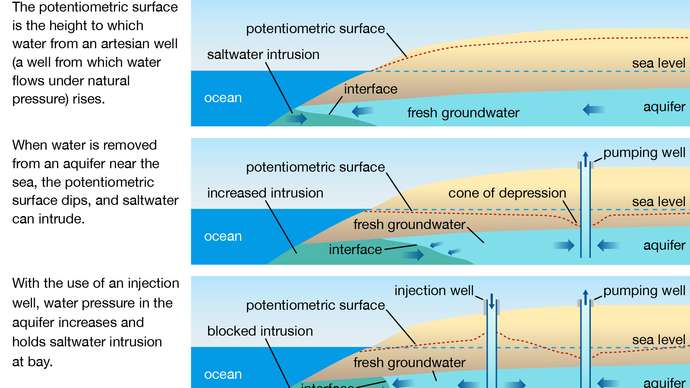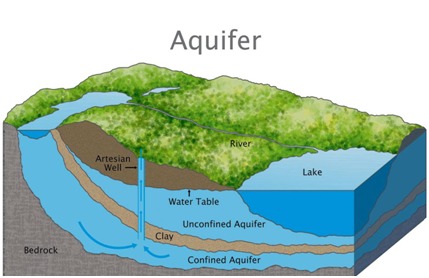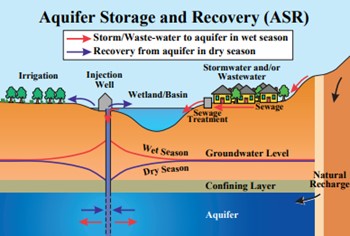Aquifer, in hydrology, rock layer that contains water and releases it in appreciable amounts. The rock contains water-filled pore spaces, and, when the spaces are connected, the water is able to flow through the matrix of the rock. An aquifer also may be called a water-bearing stratum, lens, or zone. Wells can be drilled into many aquifers, and they are one of the most important sources of fresh water on Earth.

Types :
A confined aquifer is a water-bearing stratum that is confined or overlain by a rock layer that does not transmit water in any appreciable amount or that is impermeable. There probably are few truly confined aquifers, because tests have shown that the confining strata, or layers, although they do not readily transmit water, over a period of time contribute large quantities of water by slow leakage to supplement production from the principal aquifer.
A groundwater aquifer is said to be unconfined when its upper surface (water table) is open to the atmosphere through permeable material. As opposed to a confined aquifer, the water table in an unconfined aquifer system has no overlying impervious rock layer to separate it from the atmosphere.

Recharge :
The water found in aquifers is replenished by drainage through the soil, which is often a slow process. This drainage is referred to as groundwater recharge. Rates of groundwater recharge are greatest when rainfall inputs to the soil exceed evapotranspiration losses. When the water table is deep underground, the water of the aquifer may be exceedingly old, possibly a result of a past climatic regime. A good example is the water of the Nubian Sandstone Aquifer System, which extends through several countries in an area that is now the Sahara.
The water is being used extensively for water supply and irrigation purposes. Radioisotope dating techniques have shown that this water is many thousands of years old. Similarly, the massive Ogallala Aquifer of the Great Plains in the United States no longer receives the water recharge from the Rocky Mountains that formed it during the Pliocene Epoch (5.3 million to 2.6 million years ago). The use of such water, which is not being recharged under the current climatic regime, is known as groundwater mining.
In many aquifers, groundwater levels have fallen drastically in recent times. This is commonly due to the diversion of aboveground water sources as well as to excessive groundwater mining for irrigation and other uses. Such depletion increases pumping costs, causes wells and rivers to dry up, and, where a coastal aquifer is in hydraulic contact with seawater, can cause the intrusion of saline water. Attempts have been made to augment recharge by the use of wastewaters and the ponding of excess river flows.

How do we get water out of an aquifer?
A lot of aquifers actually discharge their water naturally by emptying into streams and rivers, or by seeping out of the ground as springs. People can also get water out of aquifers by drilling a well into the subsurface down into the aquifer. These wells become unnatural access routes to the aquifer. As such it is very important to seal the outside of the well bore properly during construction. This helps prevent contaminants from entering into the subsurface. This grout can be made of many things including concrete and very fine clays. Pumps are used to pull air and then water out of the subsurface, up the well and up to the surface. Water in the pore spaces will move into the well because the pump creates differences in pressure (like a vacuum). An aquifer where water comes up to the surface without needing a pump is called an “artesian aquifer”. Some aquifers are so deep that their water never makes it to the surface naturally, but people can dig wells deep enough to pump groundwater up out of these aquifers. Some giant municipal and industrial wells can be hundreds to over a thousand feet long!

How does water get into an aquifer?
Water on the surface that comes from rain or snow melt soaks into the ground. This process is called “infiltration”. The water slowly percolates down into the aquifer by travelling in a very windy path through the pores that are connected together. When water infiltrates into the aquifer from above it is said to have “recharged” the aquifer. Some aquifers can be recharged in a matter of hours. In others the water travels so slowly that it make take hundreds or thousands of years to make it into the aquifer. The same holds true for the amount of time it takes for the groundwater to naturally move through and out of an aquifer!

Why does aquifer pollution matter?
A polluted aquifer is generally a major problem! Because so much of our supply of fresh water comes from groundwater, polluted aquifers are a source of potential threat to the public health. Also, because so many aquifers naturally drain onto the surface, a polluted aquifer can lead to a polluted environment. These aren’t the only reasons however why a polluted aquifer is such a problem. Remember that it can take groundwater a very long time to move through an aquifer, and those pollutants that get in the groundwater move just as slowly and stay just as long! Polluted aquifers are very hard to clean and it generally take many years to do so – unfortunately, sometimes it is not possible to get them all the way clean.
THE BEST WAY TO CLEAN AN AQUIFER IS
TO NEVER GET IT DIRTY IN THE FIRST PLACE!
Why are our impacts on aquifers so important?
There are a number of reasons why what we do to our aquifers is so important. In many places people are draining the aquifers faster than nature can recharge them. In some areas this rapid pumping has caused the water table to drop. This has led to many streams and springs drying up and an increase in desert-like conditions. Another reason why what we do is so important is because of how aquifers recharge. Water gets into them by draining down from the surface of the earth. So, any pollutants or toxic substances that dissolve in the water will be carried down into the aquifer too. Another way for pollution to get into the aquifer is from leaking underground storage tanks and buried wastes, such as gasoline tanks or landfill garbage. Toxins draining from these buried wastes can become mixed with the groundwater.
It is our collective, collaborative and comprehensive responsibility to protect our Aquifer. A holistic approach of each individual to ensure prevention of groundwater depletion in the Aquifer, and protection of quality of Aquifer water will be ensure better life of next generation.
“When not in use don’t let the water flow,
You must conserve the H2O’’
Vardhman Envirotech,
India’s Passionate Rainwater Company
